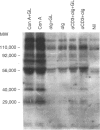Abstract
Cellular and molecular mechanisms of the immunomodulatory action of glycyrrhizin (GL) were studied. We demonstrated that GL displays a unique action to prolong the duration of the T-cell receptor-mediated in vitro splenic T-lymphocyte growth response to anti-CD3 monoclonal antibody (mAb) or concanavalin A (Con A) through enhancement of interleukin-2 (IL-2) secretion and IL-2 receptor (IL-2R) expression. The augmentation by GL of IL-2 production was also found in spleen cells stimulated with A23187 plus phorbol 12-myristate 13-acetate (PMA), suggesting that GL primarily affects some post-receptor stage of the signal transduction. We also found that the time of GL action for promoting IL-2 production and growth response was 2 hr or more after receptor activation. Correspondingly, GL did not augment the anti-CD3 mAb or Con A-mediated protein tyrosine phosphorylation and c-fos transcription. We concluded from these results that GL acts as a promoter of the late signal transduction of T lymphocytes for IL-2 production.
Full text
PDF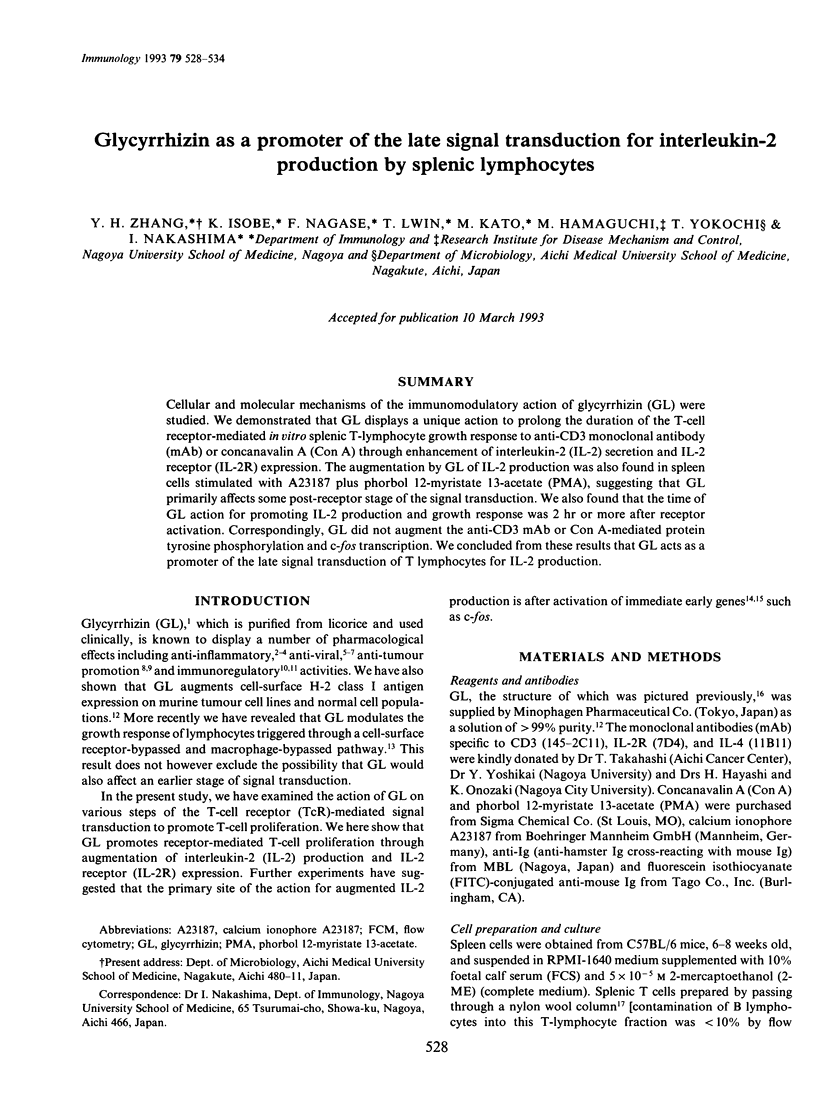
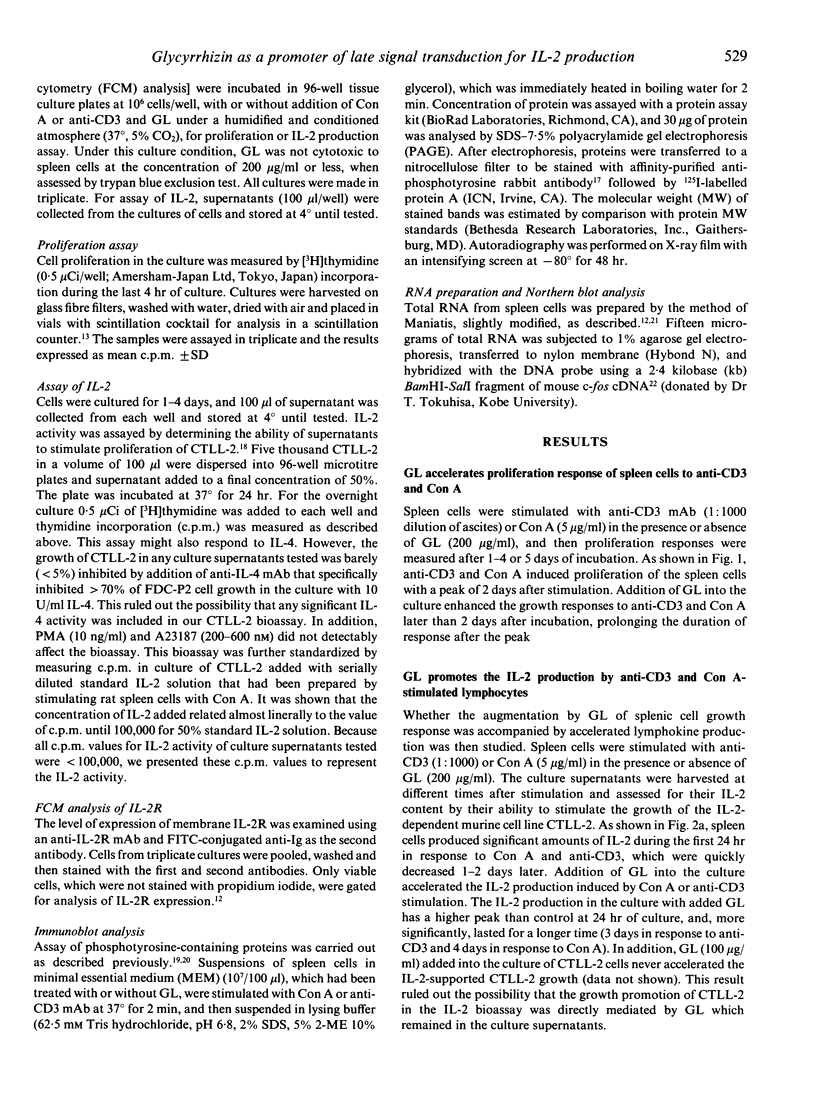
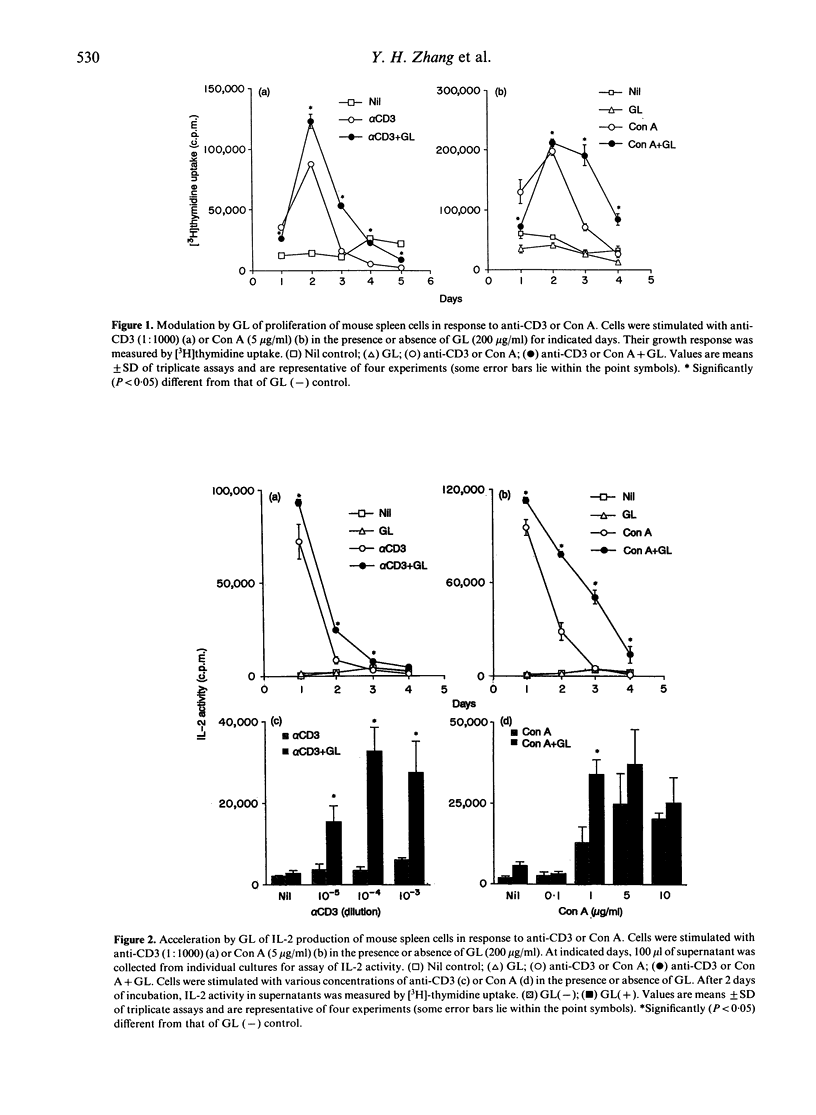
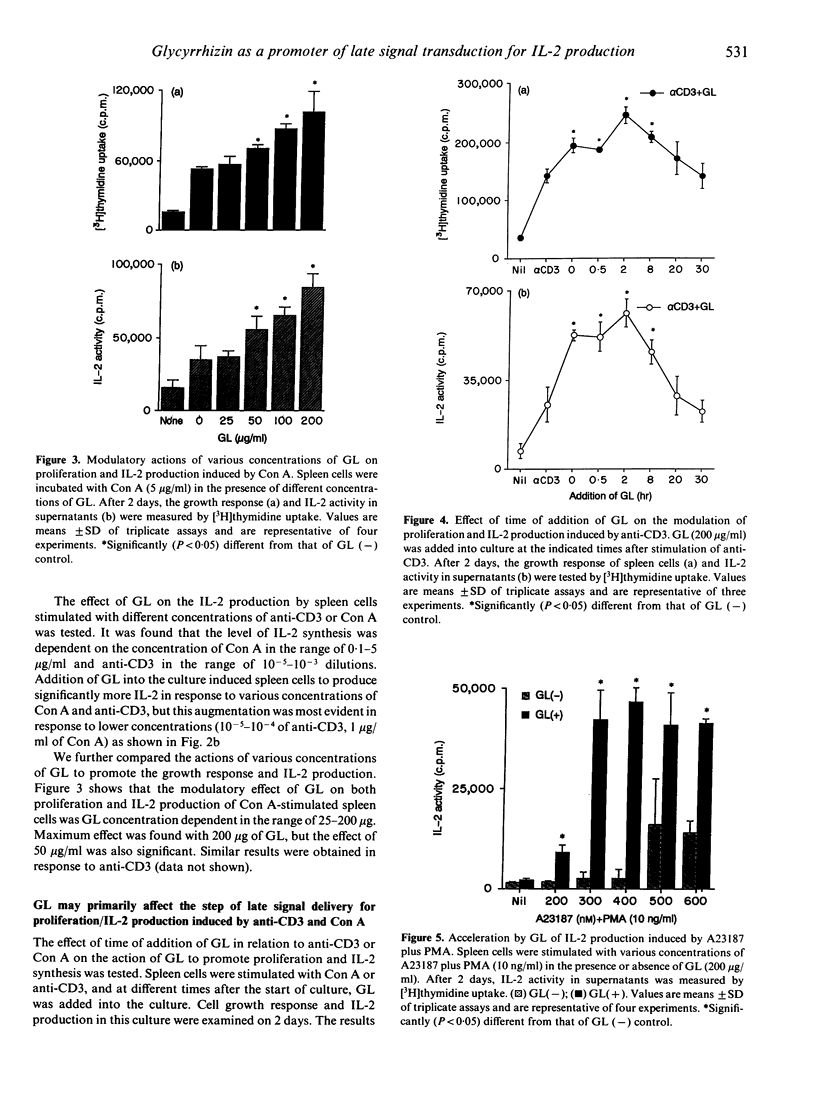
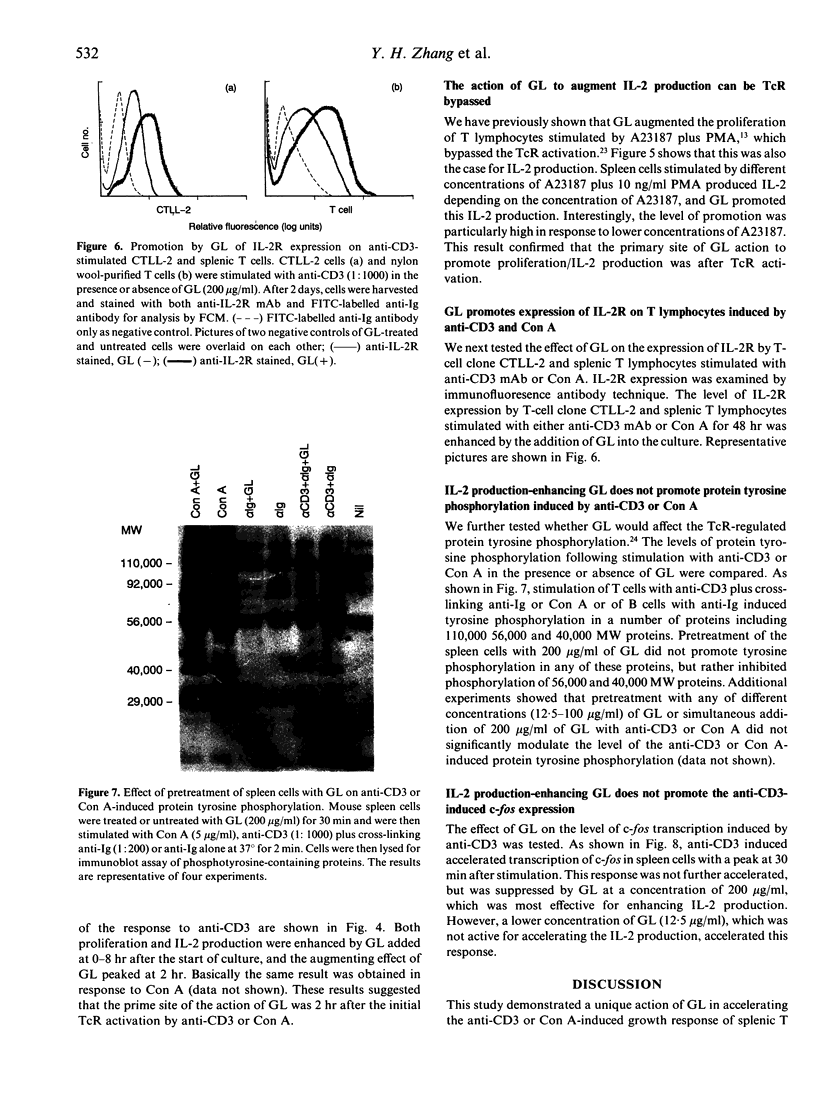
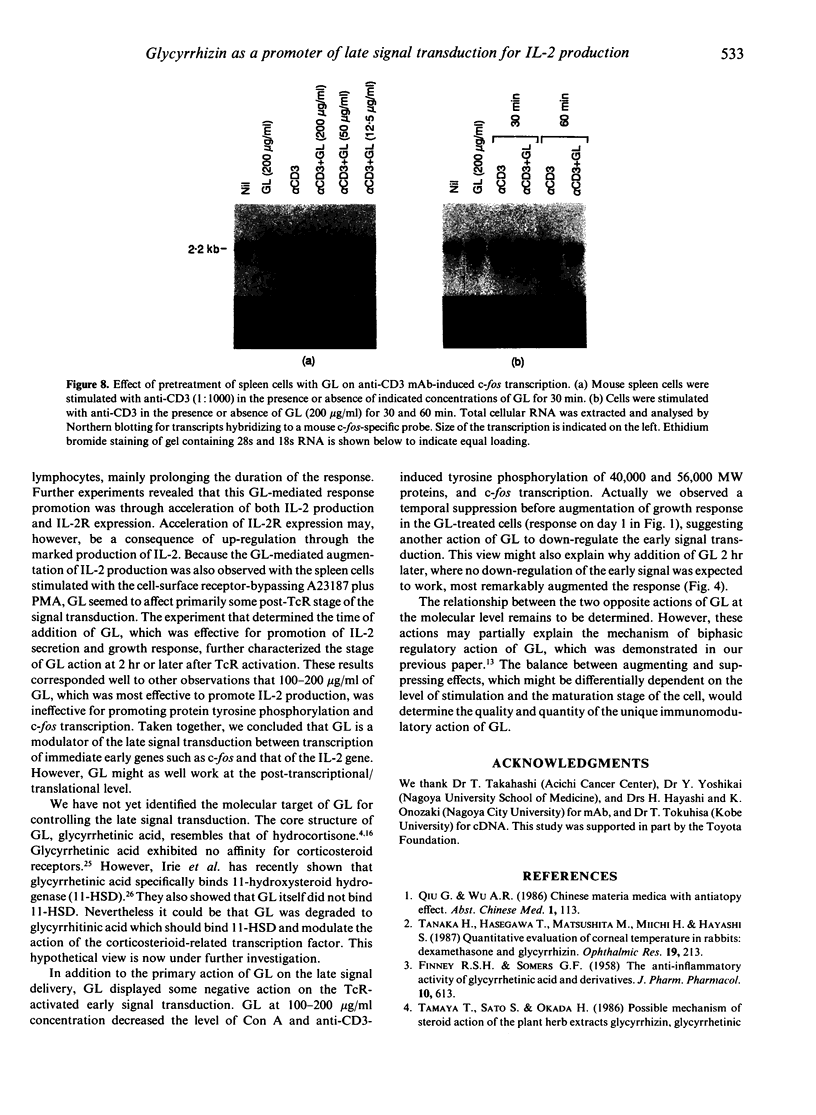
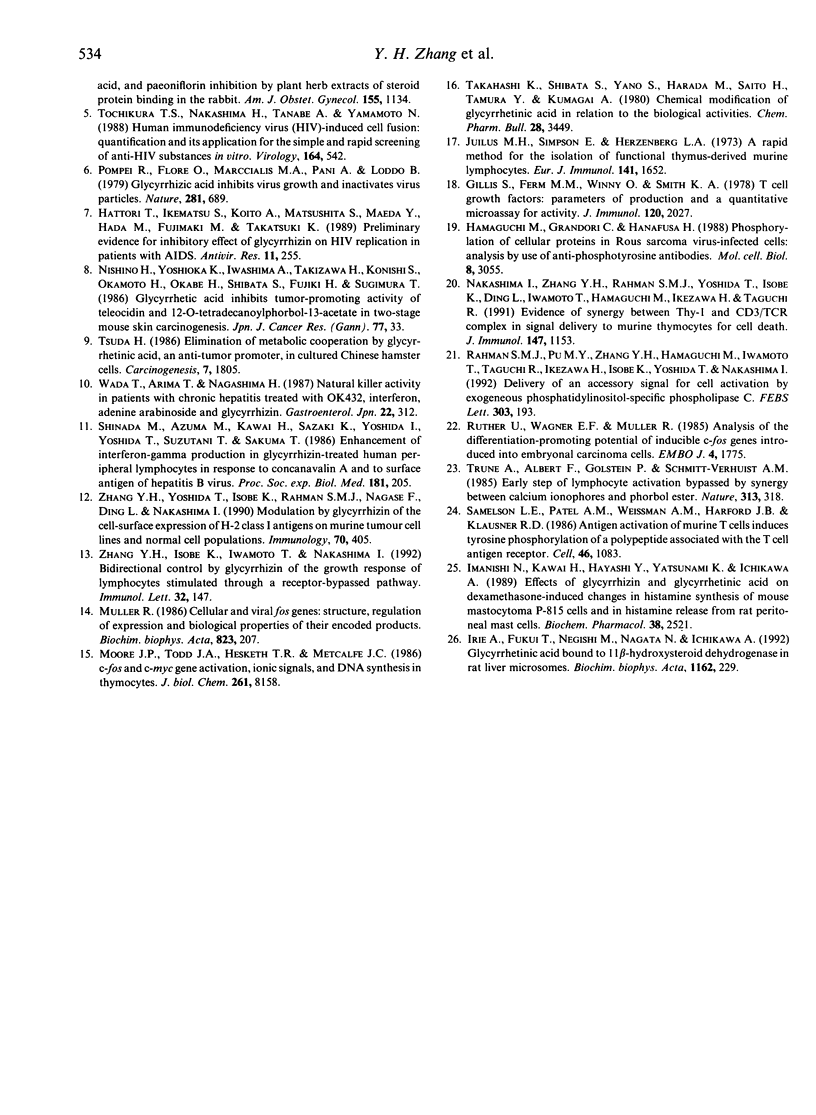
Images in this article
Selected References
These references are in PubMed. This may not be the complete list of references from this article.
- FINNEY R. S., SOMERS G. F. The antiinflammatory activity of glycyrrhetinic acid and derivatives. J Pharm Pharmacol. 1958 Oct;10(10):613–620. doi: 10.1111/j.2042-7158.1958.tb10349.x. [DOI] [PubMed] [Google Scholar]
- Gillis S., Ferm M. M., Ou W., Smith K. A. T cell growth factor: parameters of production and a quantitative microassay for activity. J Immunol. 1978 Jun;120(6):2027–2032. [PubMed] [Google Scholar]
- Hattori T., Ikematsu S., Koito A., Matsushita S., Maeda Y., Hada M., Fujimaki M., Takatsuki K. Preliminary evidence for inhibitory effect of glycyrrhizin on HIV replication in patients with AIDS. Antiviral Res. 1989 Jun-Jul;11(5-6):255–261. doi: 10.1016/0166-3542(89)90035-1. [DOI] [PubMed] [Google Scholar]
- Imanishi N., Kawai H., Hayashi Y., Yatsunami K., Ichikawa A. Effects of glycyrrhizin and glycyrrhetinic acid on dexamethasone-induced changes in histamine synthesis of mouse mastocytoma P-815 cells and in histamine release from rat peritoneal mast cells. Biochem Pharmacol. 1989 Aug 1;38(15):2521–2526. doi: 10.1016/0006-2952(89)90097-x. [DOI] [PubMed] [Google Scholar]
- Irie A., Fukui T., Negishi M., Nagata N., Ichikawa A. Glycyrrhetinic acid bound to 11 beta-hydroxysteroid dehydrogenase in rat liver microsomes. Biochim Biophys Acta. 1992 Nov 20;1160(2):229–234. doi: 10.1016/0167-4838(92)90012-3. [DOI] [PubMed] [Google Scholar]
- Jamshedur Rahman S. M., Pu M. V., Zhang Y. H., Hamaguchi M., Iwamoto T., Taguchi R., Ikezawa H., Isobe K., Yoshida T., Nakashima I. Delivery of an accessory signal for cell activation by exogenous phosphatidylinositol-specific phospholipase C. FEBS Lett. 1992 Jun 1;303(2-3):193–196. doi: 10.1016/0014-5793(92)80517-k. [DOI] [PubMed] [Google Scholar]
- Moore J. P., Todd J. A., Hesketh T. R., Metcalfe J. C. c-fos and c-myc gene activation, ionic signals, and DNA synthesis in thymocytes. J Biol Chem. 1986 Jun 25;261(18):8158–8162. [PubMed] [Google Scholar]
- Müller R. Cellular and viral fos genes: structure, regulation of expression and biological properties of their encoded products. Biochim Biophys Acta. 1986;823(3):207–225. doi: 10.1016/0304-419x(86)90003-x. [DOI] [PubMed] [Google Scholar]
- Nakashima I., Zhang Y. H., Rahman S. M., Yoshida T., Isobe K., Ding L. N., Iwamoto T., Hamaguchi M., Ikezawa H., Taguchi R. Evidence of synergy between Thy-1 and CD3/TCR complex in signal delivery to murine thymocytes for cell death. J Immunol. 1991 Aug 15;147(4):1153–1162. [PubMed] [Google Scholar]
- Pompei R., Flore O., Marccialis M. A., Pani A., Loddo B. Glycyrrhizic acid inhibits virus growth and inactivates virus particles. Nature. 1979 Oct 25;281(5733):689–690. doi: 10.1038/281689a0. [DOI] [PubMed] [Google Scholar]
- Rüther U., Wagner E. F., Müller R. Analysis of the differentiation-promoting potential of inducible c-fos genes introduced into embryonal carcinoma cells. EMBO J. 1985 Jul;4(7):1775–1781. doi: 10.1002/j.1460-2075.1985.tb03850.x. [DOI] [PMC free article] [PubMed] [Google Scholar]
- Samelson L. E., Patel M. D., Weissman A. M., Harford J. B., Klausner R. D. Antigen activation of murine T cells induces tyrosine phosphorylation of a polypeptide associated with the T cell antigen receptor. Cell. 1986 Sep 26;46(7):1083–1090. doi: 10.1016/0092-8674(86)90708-7. [DOI] [PubMed] [Google Scholar]
- Shinada M., Azuma M., Kawai H., Sazaki K., Yoshida I., Yoshida T., Suzutani T., Sakuma T. Enhancement of interferon-gamma production in glycyrrhizin-treated human peripheral lymphocytes in response to concanavalin A and to surface antigen of hepatitis B virus. Proc Soc Exp Biol Med. 1986 Feb;181(2):205–210. doi: 10.3181/00379727-181-42241. [DOI] [PubMed] [Google Scholar]
- Takahashi K., Shibata S., Yano S., Harada M., Saito H., Tamura Y., Kumagai A. Chemical modification of glycyrrhetinic acid in relation to the biological activities. Chem Pharm Bull (Tokyo) 1980 Nov;28(11):3449–3452. doi: 10.1248/cpb.28.3449. [DOI] [PubMed] [Google Scholar]
- Tamaya T., Sato S., Okada H. H. Possible mechanism of steroid action of the plant herb extracts glycyrrhizin, glycyrrhetinic acid, and paeoniflorin: inhibition by plant herb extracts of steroid protein binding in the rabbit. Am J Obstet Gynecol. 1986 Nov;155(5):1134–1139. doi: 10.1016/0002-9378(86)90365-0. [DOI] [PubMed] [Google Scholar]
- Tanaka H., Hasegawa T., Matsushita M., Miichi H., Hayashi S. Quantitative evaluation of ocular anti-inflammatory drugs based on measurements of corneal temperature in rabbits: dexamethasone and glycyrrhizin. Ophthalmic Res. 1987;19(4):213–220. doi: 10.1159/000265496. [DOI] [PubMed] [Google Scholar]
- Tochikura T. S., Nakashima H., Tanabe A., Yamamoto N. Human immunodeficiency virus (HIV)-induced cell fusion: quantification and its application for the simple and rapid screening of anti-HIV substances in vitro. Virology. 1988 Jun;164(2):542–546. doi: 10.1016/0042-6822(88)90570-3. [DOI] [PubMed] [Google Scholar]
- Truneh A., Albert F., Golstein P., Schmitt-Verhulst A. M. Early steps of lymphocyte activation bypassed by synergy between calcium ionophores and phorbol ester. Nature. 1985 Jan 24;313(6000):318–320. doi: 10.1038/313318a0. [DOI] [PubMed] [Google Scholar]
- Tsuda H., Okamoto H. Elimination of metabolic cooperation by glycyrrhetinic acid, an anti-tumor promoter, in cultured Chinese hamster cells. Carcinogenesis. 1986 Nov;7(11):1805–1807. doi: 10.1093/carcin/7.11.1805. [DOI] [PubMed] [Google Scholar]
- Wada T., Arima T., Nagashima H. Natural killer activity in patients with chronic hepatitis treated with OK432, interferon, adenine arabinoside and glycyrrhizin. Gastroenterol Jpn. 1987 Jun;22(3):312–321. doi: 10.1007/BF02774257. [DOI] [PubMed] [Google Scholar]
- Zhang Y. H., Isobe K., Iwamoto T., Nakashima I. Bidirectional control by glycyrrhizin of the growth response of lymphocytes stimulated through a receptor-bypassed pathway. Immunol Lett. 1992 Apr;32(2):147–152. doi: 10.1016/0165-2478(92)90107-y. [DOI] [PubMed] [Google Scholar]
- Zhang Y. H., Yoshida T., Isobe K., Rahman S. M., Nagase F., Ding L., Nakashima I. Modulation by glycyrrhizin of the cell-surface expression of H-2 class I antigens on murine tumour cell lines and normal cell populations. Immunology. 1990 Jul;70(3):405–410. [PMC free article] [PubMed] [Google Scholar]



